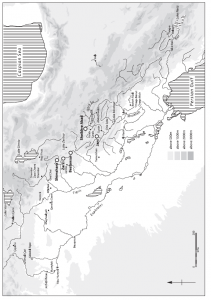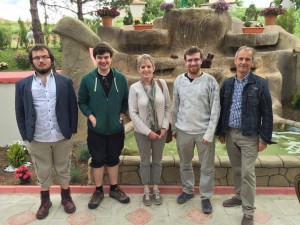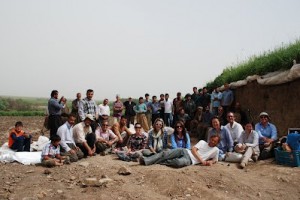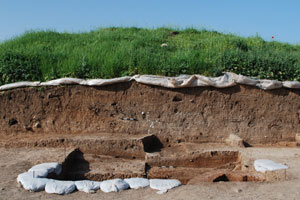Professor Roger Matthews & Dr Wendy Matthews spent their Easter at the early Neolithic site of Bestansur, Iraqi Kurdistan. The excavations at Bestansur are significant as it is such an early settlement, dating to about 7700/7600 BC. At nearly 9000 years old, this provides us with some fantastic evidence for the very first steps of the transition from hunting to farming in the Neolithic period in this region.
The discoveries this season include the careful excavation of a very special building (Building 5) made of lumps of clay with plastered walls & floor, which had an unusual number of human remains interred beneath it. The team have identified a large number of human remains, mostly disarticulated, and often from very small children.
As seen in the video linked to below, one of the theories is that the building may be a special building for the burial of dead people – some of the remains seem to be coming from quite far distances, which is why the bones are disarticulated. With some of the bodies the team also found small offerings, such as beads of clay or stone, including a bead of carnelian which would have had to be imported from Iran or Afghanistan.
About the Excavation
A University of Reading and Sulaimaniyah Antiquities Directorate team recently conducted a sixth season of excavations at the Early Neolithic settlement site of Bestansur, Sulaimaniyah Province, Iraqi Kurdistan, between 26 March and 15 April 2016. The team comprised Roger Matthews, Wendy Matthews and Kamal Rasheed Raheem (Co-Directors), Kamal Rauf Aziz and Sami Jamil Hama Rashid (Sulaimaniyah Antiquities Directorate), Amy Richardson (University of Oxford), Sam Walsh (UCLAN), Adam Stone and Tom Moore (University of Reading) and local excavators. We are very grateful to Sulaimaniyah Directorate of Antiquities for all their support, in particular to the Director, Kamal Rasheed Raheem, the Director of the Museum, Hashim Hama, and our government representatives, Kamal Rauf Aziz and Sami Jamil Hama Rashid, who helped us in many ways and contributed greatly to the success of the season. We are grateful to them all for their hard work all season.
The excavations were financially supported by generous grants from the Gerald Averay Wainwright Fund of the University of Oxford and the British Institute for the Study of Iraq. We are very grateful to these bodies for their kind support.
Excavations at Bestansur, an Early Neolithic settlement
Excavations at Bestansur focused on expansion of Trench 10 to investigate a neighbourhood of Neolithic architecture on the lower eastern slopes of the mound, in an area of 18 x 14m.
This season’s excavations in Trench 10 aimed firstly to investigate and analyse of the human burials below the floors of Space 50 and the stratigraphic context of these, and secondly to define the extent of the building in which they were placed, Building 5, radiocarbon dated to c. 7700 BC.
We established that there are an exceptional number of human remains interred within Space 50. The excavations this season increased the number of individuals identified to more than 55 people, with more remains detected but left preserved in the ground for the next season. This number of individuals is higher than that found in many houses from other Neolithic sites of the Middle East, such as Tell Halula in Syria, for example, where 5-15 individuals were buried within single buildings. The high number within Building 5 at Bestansur is larger than expected for a single household and suggests that there were extensive and long-lived inter-relations between communities.
Four principal groups of human remains were investigated in the south and east of Space 50. All of these represent selective burial of particular skeletal parts,
predominantly of skulls, long bones and ribs. Two of these groups were of mixed age ranges. One group included red-pigmented material around clusters of bones and another group included traces of white mineral material on many bones and a skull as well as red pigment. A third group comprised predominantly juveniles and infants. The fourth assemblage was represented scattered remains of human bone and beads in the fill below the floors. One unusual bead of carnelian, imported from Iran or Afghanistan, was also found (Fig. 7).
As the walls of Space 50 slope inwards, c. 10 cm of deposits have been left against the base and lower sections of the walls. These microstratigraphic sequences were carefully cleaned with an artist’s palette knife, photographed and drawn at 1:5 and 1:10 to investigate the history of the construction and use of Building 5 and the complex burial sequence throughout the foundation, occupation and infill of the Building.
The north of Building 5, the western narrow rooms and the northwest corner of Space 50 and adjacent buildings were defined by extending trench 10 to the northwest.
We will continue excavation of this extraordinary deposit and building in spring 2017 and beyond.
Recording of human remains was conducted in the field and the laboratory by osteoarchaeologist Dr Sam Walsh (Fig. 4). We are very grateful to the Sulaimaniyah Antiquities Directorate for permission to export human bones and teeth for analysis to study diet, health and mobility. We will be carrying out a full programme of analysis of this very special assemblage of human remains from the Early Neolithic period.
You can watch an interview with Roger on Rudaw TV here.









